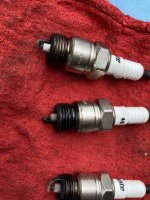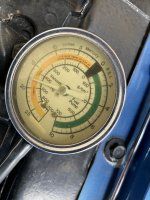Hi all,
Last summer you guys helped me to replace my timing chain, rear main seal, oil pump, and screen. I have done some minor upgrades since then but I have a feeling something doesn’t sound quite right.
I have this video showing some spark plugs I recently installed and some idle revving and driving.
Video
I am hoping some better ears can tell me if I have anything to test or fix. (My speedometer makes a tick noise around 30mph, try to ignore that).
I plan to do some tests this long weekend and I’ll post my results.
Oil Pressure Test (previous test shown pressure at 20psi after warm up)
Compression Test (last years test attached)
Tune w/ Vacuum
Any other tests?
As you will notice I have an SCV carburetor installed on my 68, however I rebuilt the carburetor and did the drop a load modification.
I suspect there to be carbon build up causing the sound or an oil pressure problem caused by old rings.
Other notes: my engine has not been getting up to temp even after 15-20 min warm up and drives. I have a plan to replace the thermostat. Also when I reinstalled the damper I did not mark it properly so my tuning is done by ear or vacuum gauge for now.
I appreciate everyone’s input and I won’t be afraid to try anyone’s suggestion.
Last summer you guys helped me to replace my timing chain, rear main seal, oil pump, and screen. I have done some minor upgrades since then but I have a feeling something doesn’t sound quite right.
I have this video showing some spark plugs I recently installed and some idle revving and driving.
Video
I am hoping some better ears can tell me if I have anything to test or fix. (My speedometer makes a tick noise around 30mph, try to ignore that).
I plan to do some tests this long weekend and I’ll post my results.
Oil Pressure Test (previous test shown pressure at 20psi after warm up)
Compression Test (last years test attached)
Tune w/ Vacuum
Any other tests?
As you will notice I have an SCV carburetor installed on my 68, however I rebuilt the carburetor and did the drop a load modification.
I suspect there to be carbon build up causing the sound or an oil pressure problem caused by old rings.
Other notes: my engine has not been getting up to temp even after 15-20 min warm up and drives. I have a plan to replace the thermostat. Also when I reinstalled the damper I did not mark it properly so my tuning is done by ear or vacuum gauge for now.
I appreciate everyone’s input and I won’t be afraid to try anyone’s suggestion.



